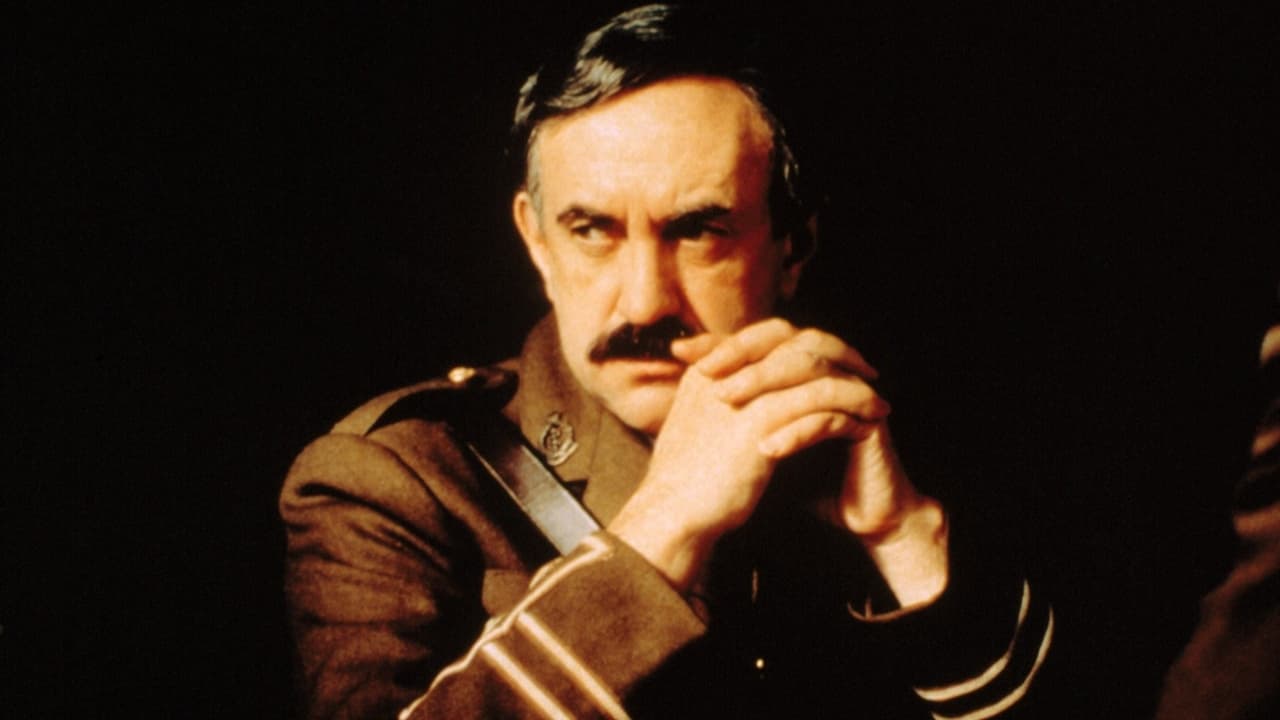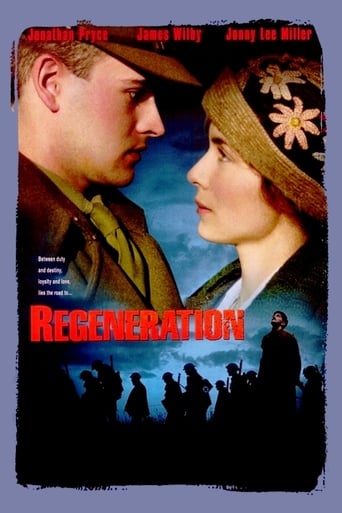TheLittleSongbird
The book by Pat Barker (which I read as part of my present AS Level English literature course) is a very good one, very poignant at times,but there are some chapters that get a bit wordy and it gets quite complicated. In my opinion, I think the film Regeneration is outstanding, with wonderful performances, and fairly true to the book. True, Burns' encounter with the animals was done at the beginning, in alternative to halfway through the first part of the book, but either way, it would have had a big effect on me, and I thought personally that scene was a lot more disturbing in the film. The music is sensitive and very beautiful, and the direction is nothing short of solid. The cinematography is absolutely fabulous, and very realistic. Regeneration offers a different perspective of war, instead of the horrific realities conveyed in poems from Owen and Sassoon (referenced in the film), and in books like Birdsong, Regeneration concentrates on the mental and psychological effects on the soldiers sent to Craiglockhart. The result is a sometimes moving but always thought provoking account of the first world war. The performances were brilliant, especially Jonathan Pryce as the methodical but fairly sensitive Rivers. Also impressive was Johnny Lee Miller as Prior, and James Wilby as Sassoon, creating very harsh but somewhat likable characters. The exploration of other themes like role of women and politics were well developed but never interfered with the true focus of the film. All in all, a moving, intelligent and thoughtful account of the first world war, not only inferring the harsh realities but also conveying the physical, mental and spiritual consequences of the soldiers. 10/10 Bethany Cox.
Cosmoeticadotcom
In 1998 I saw a great war film that was lost in the glare of the nearly simultaneous American film releases of Terrence Malick's remake of The Thin Red Line- which is a great film, and Steven Spielberg's cliché and stereotype-dripping Saving Private Ryan. It was a 1997 Canadian and British film called Regeneration, directed by Gillies MacKinnon (who directed The Playboys, and Small Faces), based upon the famed book of the same title by British novelist Pat Barker. The screenplay was written by Allan Scott. There were a couple of differences between it and the other films; the first being that it was set during World War One, in 1917, while the other two took place during World War Two. The second was that Regeneration may have been the best film of the trio. In the years since, I have searched for the film on DVD, but it only was available in a Region 2 DVD format. Then, I recently found it online, released by Artisan DVD, for American audiences. The DVD is as bare bones as one can get- not a single bonus feature. But, even worse is the fact that it was released under a different, and far less compelling and more trite, title of Behind The Lines. Worse yet is the fact that this film is a bowdlerized, dumbed down version of the great film I remember seeing.While I cannot pinpoint all the changes from the original film, the overall effect on me was not as great. Oh, it's still a good film, but the greatness has been lost due to the cutting out of some scenes entirely and the trimming of others- to get the nearly two hour original film down to 95 minutes, and re-editing the film into shorter scenes that are interspersed with each other, designed to appeal to a more MTV and video game mindset. Lost in the rush to appeal to typical American idiocy was most of a small romantic subplot, and extended scenes between two of the main characters, the War Poets Siegfried Sassoon (James Wilby) and Wilfred Owen (Stuart Bunce). One has to guess that if the film had too much poetry in it that the McDonald's fed masses would be turned off. Yet, the worst cut, for me, comes about two thirds into the film, where Dr. Rivers (Jonathan Pryce), head of the asylum- Craiglockhart War Hospital in Edinburgh, Scotland, where shell-shocked soldiers go for psychotherapy, goes to London, on R&R, to visit a colleague, Dr. Yealland (John Neville), who is using a very effective form of electroshock therapy to get soldiers suffering from mutism to speak again. All these years later it was that scene, above all others, which stood out in my memory. As a mute soldier is strapped down and about to be shocked for the first time, the camera cuts away from the soldier, and as his agonal screams ripple outward, one only sees the slightly winced reaction of the doctor. It's a brilliant cut and displays the director's command of his craft, for it's a) always better to imagine such horrors, and b) the doctor is the more important character. However, in the Americanized DVD version, all that is lost. We see a standard, even generic, editing job of pain, the doctor wincing, pain, the doctor hanging his head, etc. Thanks, my native land!The film still has, however bowdlerized, more contemporary relevance than the other two films which drowned it out in 1998, if only because- given the current U.S. treatment of both its Prisoners Of War and veterans of the Iraq War, it shows how little supposedly 'civilized nations' have come in almost a century of warfare. It also touches on smaller aspects of the war, like mail censorship, which are never shown in war films, much less even discussed in many for a regarding warfare. While The film lacks the high tech graphics of its bigger budgeted cousins from 1998, the words of some of the poems, and the reactions of the soldiers say far more than mere 'shocking' images can, for words that are well chose can never inure their readers. Images, even great ones, can do just that through sheer repetition. That said, the best images in the film are not elaborate war scenes, but those designed to show the aftereffects of war on the human body and mind. As example, there is a young soldier who is a quivering wreck, wont to running naked through the woods and mutilating himself, because, we learn, he was thrown by a shell explosion, into the air and when he regained consciousness he was lying face down in the rotted corpse of a German soldier. Hearing what caused him to become so disturbed is more effective than showing his face inside a bloodied, rotting mass of flesh, for, as in the cut scene of Dr. Rivers turning away from the sight of electroshock therapy, what is imagined is always worse than what can be portrayed, for each individual will fill in the horror with their own fears, rather than having a fixed image in their minds.The cinematography, by Glen MacPherson, is stunningly realistic yet beautiful- especially in the sepia-tinged, color leeched war sequences, but throughout the whole film, as well; and it works well with the simple and understated musical score. It is a stark reminder that, then and now, one need not have all the high tech big budget special effects wizardry of a Steven Spielberg film to leave far more haunting images- perhaps the most effective one left in this bowdlerized film is the opening of a pair of human eyes buried in mud, so that the whites burn with startling intensity up at the viewer. If only the American distributors had not so badly butchered this film, from the title on, the rest of the film would have retained the intensity of those eyes which held me through nearly a decade.

